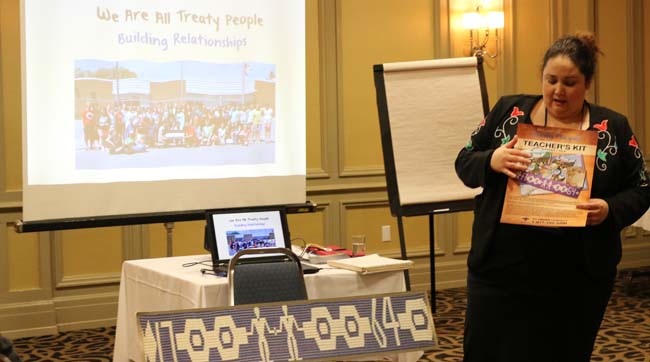Anishinabek Nation leading the way in treaty relationship education

By Joey Krackle
NIPISSING FN — The Union of Ontario Indians (UOI) is at the forefront of implementing the Truth and Reconciliation Commission Report (TRC) recommendations in the area of public education as a foundation to promote better understanding and improved relationships between First Nations and all people in Ontario.
The UOI has also been addressing throughout the years the recommendations from the Royal Commission on Aboriginal Peoples and the Report of the Ipperwash Inquiry where it involves public education on First Nations issues and developing educational materials about treaty relationships.
“We’ve created two Ipperwash booklets to give a background to the events and history surrounding the shooting death of Dudley George by an OPP sniper,” says UOI communications officer Marci Becking. “In 2011 we published ‘We are all Treaty People’ which has sold more than 9,000 copies in Canada – making it a National Best Seller. It was written by Maurice Switzer, citizen of Alderville First Nation and illustrated by Charley Hebert, citizen of Dokis First Nation.
Furthermore, UOI developed a video to accompany the book, in addition to teacher activities such as a LEGO replica of the Treaty of Niagara wampum belt designed by then 7 year-old Dokis FN citizen Alex Hebert and asked M’Chigeeng First Nation citizen, teacher/principal Kelly Crawford to tie it all together. “Kelly Crawford wrote a teachers’ resource to accompany the book ‘We are all Treaty’ People’ and UOI packaged it into one kit for schools all over Ontario to use,” says Becking. “The teachers guide speaks to the treaty relationship and links activities to the Ontario curriculum for Grades 1-8. School Boards all over the province have been ordering the kit and are pleased that such a resource now exists.”
Becking points out that the “We are all Treaty People” teachers resource will be available in French in February. “We’ve received many calls from the French school boards,” says Becking. “They are very excited that we are working on the translation of the kit.”
Maurice Switzer, while at UOI, also complied the book “Nation to Nation: A Resource on Treaties in Ontario” in 2013. “’Nation to Nation’ will now become part of a Secondary School teachers’ resource that Kelly Crawford is developing,” says Becking. “It also will include the book ‘Little Butterfly Girl’ written by legal counsel Jenny Restoule-Mallozzi, citizen of Dokis First Nation and illustrated by Nipissing First Nation artist Donald Chretien. ‘Little Butterfly Girl’ is about one girl’s experience at Indian Residential School. I’m excited that we’ve already been fulfilling the recommendations of the TRC report – education is a huge part of reconciliation and we’re leading the way for public education.”
The Secondary School relationship resource will be launched in spring 2016.
TRC Chair Justice Murray Sinclair strongly supports the importance of public education as the way to achieve reconciliation. Education is the key to reconciliation. By educating our children, we can change the way adults think and act and thereby create more permanent change. He estimated that it would take three to five generations to erase the 7 generations of oppression and colonialism since Confederation in 1867.
The TRC is a component of the Indian Residential Schools Settlement Agreement and was announced in 2009 and began its work in 2010 under Chair Justice Murray Sinclair. The TRC mandate is to inform all Canadians about what happened in Indian Residential Schools (IRS). The Commission will document the truth of survivors, families, communities and anyone personally affected by the IRS experience. This includes First Nations, Inuit and Métis former Indian Residential School students, their families, communities, the Churches, former school employees, Government and all Canadians. The TRC was established with the goal of guiding and inspiring Aboriginal peoples and Canadians in a process of reconciliation and renewed relationships that are based on mutual understanding and respect.
Sinclair emphasizes the TRC call for the establishment of a Council for Reconciliation, a Royal Proclamation of Reconciliation and a review of the Indian Act. He asserted that the federal and provincial governments could no longer continue to suppress indigenous Canadians as being a constructive path towards reconciliation.
Justice Sinclair also states that he was pleasantly surprised that many Canadian organizations embraced the challenges of reconciliation and were working on implementing TRC recommendations. He stated that provinces and territories, especially the departments of education in Ontario, Manitoba, Alberta, Saskatchewan, Northwest Territories and Nunavut were currently revising their school curricula. He emphasized that teachers were especially keen and had requested copies of the report. He pointed out that child welfare workers, crown attorneys and defence lawyers had been in touch with the TRC to ask how to utilize the information.
The following organizations were working on the TRC Calls to Action: the medical professions; law societies; university law schools; and labour and municipal organization — especially those located in major cities.
To order resources, please email news@anishinabek.ca


